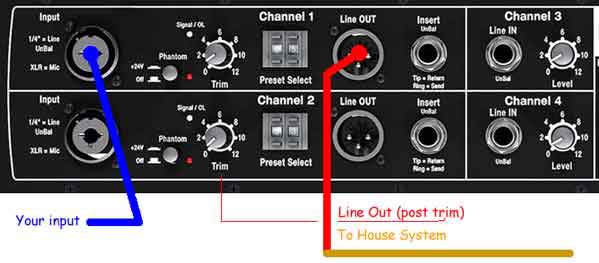Difference between revisions of "PS1 Powerstand Connections/Line Out/XLR"
m (→XLR Line Outs Channels 1 and 2) |
m (→Line Outs (XLR balanced) for Channels 1 and 2: simplified wording about the location of the pad) |
||
| Line 1: | Line 1: | ||
== Line Outs (XLR balanced) for Channels 1 and 2 == | == Line Outs (XLR balanced) for Channels 1 and 2 == | ||
* post trim (+4 dBu nominal) | * post trim (+4 dBu nominal) | ||
| − | For Channels One or Two you can run an XLR cable to the House or recording console like this. The outputs are post-trim (+4 dBu nominal). This is not suitable for connection to another {{PS1}} as the output level is too high for a {{PS1}} Channel 1 or 2 input. If you want to daisy-chain {{PS1}}s use a [[pad]] between the Systems | + | For Channels One or Two you can run an XLR cable to the House or recording console like this. The outputs are post-trim (+4 dBu nominal). This is not suitable for connection to another {{PS1}} as the output level is too high for a {{PS1}} Channel 1 or 2 input. If you want to daisy-chain {{PS1}}s use a [[pad]] between the Systems. You would probably put the pad at the input of the second {{PS1}}. Note the position of the pad in the diagram below. |
Revision as of 02:55, 25 November 2008
Line Outs (XLR balanced) for Channels 1 and 2
- post trim (+4 dBu nominal)
For Channels One or Two you can run an XLR cable to the House or recording console like this. The outputs are post-trim (+4 dBu nominal). This is not suitable for connection to another PS1 Power Stand (Classic) / Model I as the output level is too high for a PS1 Power Stand (Classic) / Model I Channel 1 or 2 input. If you want to daisy-chain PS1 Power Stand (Classic) / Model Is use a pad between the Systems. You would probably put the pad at the input of the second PS1 Power Stand (Classic) / Model I. Note the position of the pad in the diagram below.
